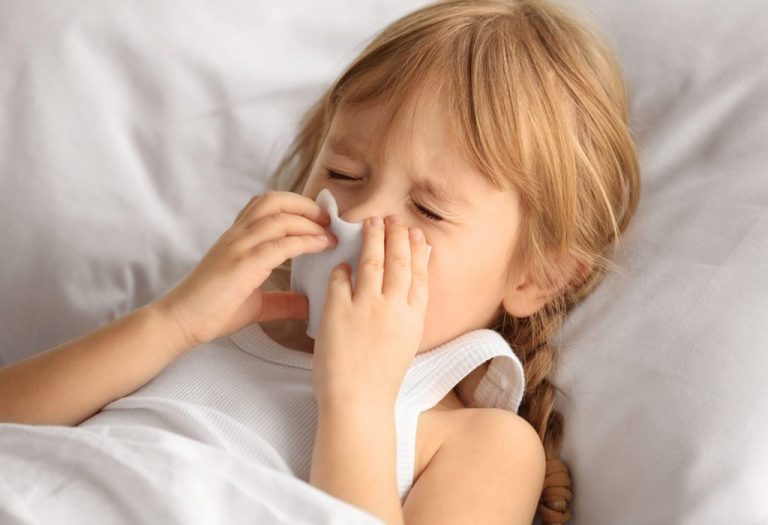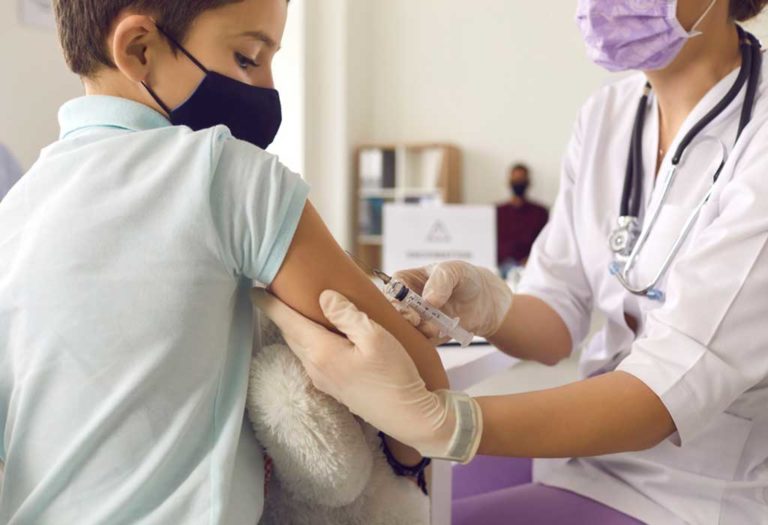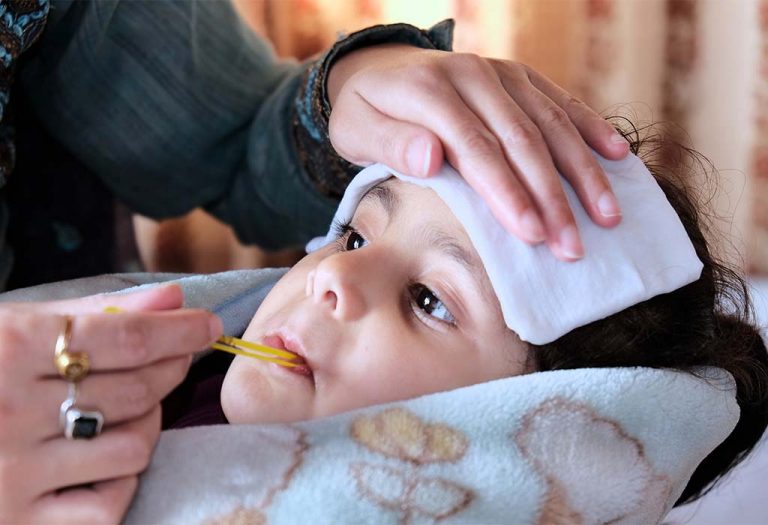Gastritis in Kids – Causes, Signs and Treatment
- What Is Gastritis?
- Type of Gastritis in Kids
- What Are the Causes of Gastritis in Kids?
- Signs and Symptoms of Gastritis in Kids
- Complications of Gastritis in Kids
- How Is Gastritis Diagnosed?
- Treatment for Gastritis in Kids
- How to Prevent Gastritis in Kids?
- Foods That Reduce Gastritis in Children
- Food to Avoid During Gastritis
- Home Remedies for Gastritis in Children
- When to Call the Doctor?
- FAQs
Gastritis is a stomach condition that is most frequently seen in older people. The condition causes the stomach lining to inflate, leading to pain, nausea, bloating, and discomfort. Gastritis is usually the result of excessive alcohol consumption, prolonged usage of anti-inflammatory drugs such as aspirin or ibuprofen, injury, major surgery, and infections. The question that arises here is, ‘Can gastritis in kids occur as well?’ Sometimes gastritis is also seen in children because of several reasons. If your child is diagnosed with gastritis, continue reading for all you need to know about the condition, its causes, and treatment.
What Is Gastritis?
The stomach has a protective lining of mucus called mucosa that shields the stomach lining from the harsh digestive acids secreted in the stomach. When this mucus layer gets damaged through a physical injury or bacterial infection, the lining can get inflamed, leading to the condition (1). Gastritis can start suddenly as acute gastritis or develop gradually over time as chronic gastritis.
Type of Gastritis in Kids
Yes, gastritis in children can also happen. It usually happens when children’s eating habits are supervised optimally. In such cases, they consume about anything that could jeopardise their health (2).
1. Acute Gastritis
Acute gastritis starts as a sudden inflammation of the stomach lining. It causes sharp and severe pain along with discomfort. However, the pain is short-lived and often comes as a short bust. Acute gastritis is caused by eating spicy foods and swallowing substances that irritate the stomach lining or objects such as batteries in children.
2. Chronic Gastritis
Chronic gastritis, on the other hand, starts slowly and builds over time. It can be caused by using certain medications, such as aspirin or ibuprofen, for a long time or the consumption of spicy foods for a long time. Chronic gastritis is more harmful as it slowly wears away the stomach lining and may lead to cancer if left untreated.
What Are the Causes of Gastritis in Kids?
The different causes of gastritis in kids are as follows (3):
1. Bacterial Infection
One of the most common causes of gastritis in children is infection by Helicobacter pylori. While most people’s bodies are adapted to fight the bacteria, some people are thought to be more vulnerable to it. The Hpylori bacteria have the benefit of overcoming the mucosal defences and causing chronic gastritis, further leading to ulcers (1).
2. Medications
Regular use of pain medications such as aspirin and ibuprofen can lead to acute gastritis. These medicines interfere with a key process that helps in the preservation of the stomach lining.
3. Stress
Severe stress caused by the onset of a disease or injury or any other reason can lead to acute gastritis in children.
4. Autoimmune Condition
Sometimes, the body’s immune cells attack the stomach lining in a condition called autoimmune gastritis. The effect is that the stomach’s protective barrier is worn off, leading to inflammation. The condition is also linked to the deficiency of vitamin B12. Autoimmune gastritis is commonly seen in people with other autoimmune disorders such as Type 1 diabetes and Hashimoto’s disease.
5. Other Conditions
Gastritis can also be triggered by other medical conditions, including parasitic infection, Crohn’s disease, and HIV/AIDS.
Signs and Symptoms of Gastritis in Kids
Here are the gastritis symptoms in kids (4) (5):
- Stomach upset and pain
- Belching and more hiccups than usual
- Abdominal bleeding
- A feeling of nausea accompanied by vomiting
- Feeling full makes them refuse food
- Burning sensation in the stomach
- Loss of appetite in general
- Abdominal bleeding leading to blood in vomit or stool
Complications of Gastritis in Kids
Chronic gastritis can be harmful for children in the long run as it increases the risk of other health conditions such as:
- Peptic ulcer disease, causing painful sores in the upper digestive tract, making it hard to eat anything spicy
- A small mass of cells in the stomach lining called gastric polyps
- Stomach tumors that can be benign or cancerous
- If the cause of the H. pylori bacteria or an autoimmune condition, it can cause atrophic gastritis. This condition destroys the inner lining of the stomach that secretes the digestive juices. In the long run, it elevates the risk of getting cancer and also lowers the stomach’s capacity to absorb certain vitamins.
How Is Gastritis Diagnosed?

If the child presents with symptoms of gastritis, the doctor will perform tests for diagnosis such as:
1. Upper Gastrointestinal Series or Barium Swallow
This procedure uses X-rays to image and observe the top portion of the digestive system. It can be used to check the oesophagus, stomach, and duodenum, which is the beginning of the small intestine. The person is made to swallow a metallic fluid that consists of barium. The barium forms a coating on the internal surfaces of the organs, making them highly visible on the X-ray.
2. Blood Tests
Blood tests can be used to determine various factors that can cause the disease. Doctors will look for the H. pylori bacteria that are present in the stomach. They also test for anemia and lack of certain vitamins that are a result of gastritis.
3. Stool Sample Test
Stool samples might be taken in the diagnostic process to look for stomach bacteria that can cause the disease. A small sample of the stool will be sent to the lab to look for bacteria and traces of blood that can indicate stomach lining bleeding.
4. Breath Test
If infection by H. pylori bacteria is suspected, a capsule with liquid containing urea will have to be swallowed. Since the bacteria act on urea to produce carbon dioxide, the breath after exhaling into a balloon will show elevated carbon dioxide levels.
5. Upper Endoscopy
Upper endoscopy is used to examine the inside of the stomach and intestines. The procedure involves sending a thin tube inside the stomach through the mouth to watch the insides in real time. If required, they can also take a small sample of the tissue. The endoscopy gives clear images of any inflammation, bleeding, or accumulated mass of cells inside the stomach.
Treatment for Gastritis in Kids
Gastritis treatment depends on several factors, such as the symptoms, severity, age, and other conditions that might be present. In general, these treatment approaches can be expected (6):
- To reduce the stomach acid’s effect on the lining and give symptomatic relief, antacids would be prescribed to the children in the beginning. As the antacids neutralize the stomach acids, the lining will have time to heal.
- If any other condition causes gastritis, the condition will also be treated simultaneously.
- If H. pylori bacteria cause gastritis, then antibiotics will be prescribed to kill the bacteria. A proton pump inhibitor (PPI) medication will also be given to reduce the stomach acids. Medicines for diarrhea will also be given to balance the gut and give symptomatic relief.
- The treatment will also involve diet restrictions and control to ensure foods that irritate the stomach lining is not consumed.
How to Prevent Gastritis in Kids?
Gastritis can be prevented by taking simple measures such as:
1. Controlled Diet
Avoid giving them foods that are known to irritate their stomach. It could include a range of spicy or acidic foods such as salsa, chilies, and citrus fruits. Other foods include red meats, dairy products, and high protein foods such as beans which take more time to digest. Encourage lighter meals and drinking water. Feed your child at least three hours before they go to sleep.
2. Precautions With Small Toy Parts
Buttons cells are often swallowed by young children, causing a sudden onset of gastritis as the batteries irritate the stomach lining. Ensure they do not have access to small parts that can be easily swallowed.
3. Stress Management
If the child is stressed by other diseases or events daily, it is essential to help them relax. Stress increases acidity, which makes gastritis worse. Teach them yoga, mindfulness, and breathing techniques that help release stress.
4. Avoid Medications
Avoid medications that are known to cause stomach troubles.
Foods That Reduce Gastritis in Children
Certainly, there are foods that you can feed your little one to soothe the symptoms of gastritis in children. Here are some:
- Low acidity foods
- High-fibre foods, including apples, carrots, oatmeal, beans, and broccoli
- Low-fat foods like fish and chicken
- Vegetables as they have alkalis
- Non-carbonated and non-caffeinated drinks
- Probiotics like buttermilk, yogurt, and curd
Food to Avoid During Gastritis
Here are the food categories to avoid:
- Deep-fried foods
- Spicy foods
- Highly acidic foods
- Carbonated drinks and sodas
- Food that has caffeine in them
- Pickled foods
- Fatty foods
- Excessive salty food
- Food with vinegar
- Fruit juice
Home Remedies for Gastritis in Children
Home remedies act as effective treatment options to treat the condition at home without any heavy medications. Here are three popular home remedies you can easily try at home:
1. Yogurt and Turmeric
Yogurt is a perfect source of probiotics, strengthening the digestive tract and gut health. Rich in protein, calcium, vitamins, and probiotics, yogurt enhances good bacteria in the gut and is especially beneficial for kids. Turmeric, on the other hand, is known for its antibacterial, anti-inflammatory, and antiviral properties, making it an effective home remedy for gastritis and stomach inflammation.
What You’ll Need:
- Yogurt
- Turmeric powder
How to Consume: Add a pinch of turmeric powder to yogurt and consume it daily.
2. Kanji
A popular Indian fermented drink, Kanji is loaded with probiotics that aid digestion, reduce bloating, and promote a healthy gut. With its tangy, spicy, and tart flavour, it serves as a detox drink in India, especially after festival feasts, to alleviate digestive issues.
What You’ll Need:
- Water
- Carrots
- Beetroots
- Asafoetida (Heeng)
- Mustard seeds
- Turmeric
- Salt
Method:
- Thoroughly wash and chop carrots and beetroots.
- Boil water and add the chopped beetroot and carrot, mustard seeds, a pinch of turmeric, asafoetida, and salt as per taste.
- Let the mixture cool. Frequently stir the ingredients to let the air move.
- Now, pour the mixture into a clean and dry glass jar and let it ferment for 3-5 days.
How to Consume: Drink one glass of kanji every day.
3. Kefir
Kefir is a fermented drink made from bacteria and yeast, similar to yogurt, but with a 24-hour fermentation process. It has a tangy flavour and a drinkable yogurt-like consistency. Rich in probiotics, kefir supports gut health, digestion, and the immune system.
How to Consume: Consume 1-2 cups of kefir daily.
4. Coconut Water
Fresh coconut water is one of the most simplest food items to soothe gastritis. It contains essential minerals and vitamins, as well as electrolytes, that help soothe the inflammation of the stomach.
How to Consume: Drink one glass of fresh coconut water daily.
5. Honey
An excellent prebiotic known for maintaining the flora of gut, honey can help with gastritis very easily. Because of its soothing properties, it treats stomach ulcers, bloating, and inflammation.
How to Consume: Mix one to two teaspoons of honey in warm water and have it daily.
When to Call the Doctor?
Symptoms of acute gastritis arising from food consumption or sudden onset of stress can be managed at home with OTC medications and dietary changes. However, if the symptoms persist over a few days or worsen, it is time to call the doctor. Bloody stools or stools that look charred or tarry need immediate medical attention.
FAQs
1. Why processed sugar and meat are avoided during gastritis?
When food with processed sugar or meat is consumed, the sugar is broken down in the mouth by bacteria in the saliva. This causes inflammation in the body, which leads to weakened immunity.
2. How do you recognise gastritis pain, specifically from other pains?
The pain from gastritis usually happens in the stomach, in the upper middle abdomen region. While the general pain from inflammation will feel somewhere in the stomach area and you won’t be able to pinpoint the exact spot, but if you have an ulcer, you will be able to pinpoint the spot exactly because of the gnawing feeling (2).
3. What are the complications of severe gastritis in children?
According to a 2020 study, severe gastritis in children may lead to a reduction in the level of the Hb and Htc levels (4).
4. What is the difference between gastritis, gastropathy, and gastroenteritis?
Although they both sound similar, gastritis and gastroenteritis are different conditions. Gastroenteritis is a condition when there is inflammation (irritation) of the stomach and intestines, usually caused by an infection. Gastritis, on the other hand, is the inflammation of the stomach lining, which is not always specifically caused by an infection. Gastropathy is the condition of the damage of the stomach lining with little to no inflammation (7).
Gastritis in children can be caused by a sudden onset (acute gastritis) or slowly over time (chronic gastritis). The condition causes pain and discomfort in children, but the general prognosis is good with immediate treatment.
References/Resources:
1. Gastritis in Children; Drugs.com; https://www.drugs.com/cg/gastritis-in-children.html
2. Gastritis; Cleveland Clinic; https://my.clevelandclinic.org/health/diseases/10349-gastritis
3. Gastritis; CHOC; https://www.choc.org/programs-services/gastroenterology/gastritis/
4. Săsăran. M. O, Meliţ. L. E, et al.; Pediatric gastritis and its impact on hematologic parameters; Medicine (Baltimore).; PubMed Central; https://www.ncbi.nlm.nih.gov/pmc/articles/PMC7458204/; August 2020
5. What Is Gastritis?; Nemours KidsHealth; https://kidshealth.org/en/kids/gastritis.html
6. Gastritis; NHS; https://www.nhs.uk/conditions/gastritis/
7. Gastritis & Gastropathy; NIDDK; https://www.niddk.nih.gov/health-information/digestive-diseases/gastritis-gastropathy
Also Read:
Indigestion in Kids
Mesenteric Adenitis in Children
Acid Reflux (GERD) in Kids
West Nile Virus in Children
Was This Article Helpful?
Parenting is a huge responsibility, for you as a caregiver, but also for us as a parenting content platform. We understand that and take our responsibility of creating credible content seriously. FirstCry Parenting articles are written and published only after extensive research using factually sound references to deliver quality content that is accurate, validated by experts, and completely reliable. To understand how we go about creating content that is credible, read our editorial policy here.























